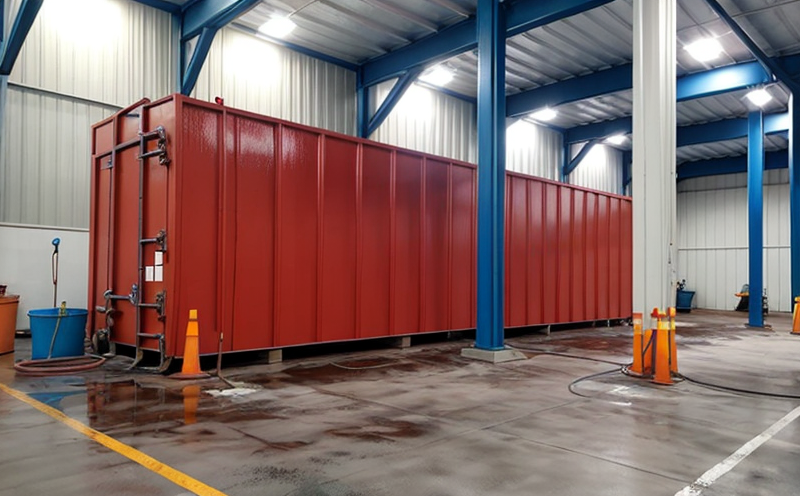ISO 2178 Magnetic Thickness Testing of Coatings on Ferrous Metals
The ISO 2178 standard provides a method for measuring the thickness of coatings applied to ferrous metals using magnetic testing techniques. This non-destructive testing (NDT) method is widely used in industrial manufacturing and processing sectors, particularly where robust corrosion protection is essential. The technique relies on the magnetic properties of ferrous metals to determine coating thickness by measuring changes in the magnetic field.
The process involves passing a magnetic field through a sample that has been coated with an insulating layer. Variations in coating thickness alter the magnetic permeability, resulting in measurable variations in the magnetic flux density across the test area. This makes ISO 2178 particularly useful for quality control and compliance purposes.
The standard is applicable to coatings on ferrous metals that have a relative magnetic permeability of at least 500 and are not electrically conductive, such as iron, steel, or cast iron substrates. The method is suitable for both organic and inorganic coatings, including paints, varnishes, lacquers, and certain types of metallic platings.
ISO 2178 testing is critical in ensuring that the protective layer is adequate to prevent corrosion, which can lead to costly failures and downtime. Industries such as automotive, aerospace, and marine rely heavily on this method for quality assurance. The results are used to verify compliance with internal specifications or regulatory requirements.
For accurate results, specimens must be prepared according to the standard's guidelines. This includes cleaning the surface of the substrate, ensuring uniformity across the test area, and avoiding any magnetic saturation that could interfere with the testing process. The thickness gauge used for measurement should also adhere strictly to ISO 2178 specifications.
The testing procedure involves calibrating the instrument using reference materials or standards that match the expected coating thickness range. The operator then applies a known magnetic field and measures the induced flux density. By comparing this data against established calibration curves, an accurate thickness can be determined.
Given its reliance on magnetic properties, ISO 2178 is not suitable for all types of coatings or substrates. For instance, it cannot be used effectively on non-ferrous metals like aluminum, copper, or their alloys due to differences in magnetic permeability. Similarly, highly conductive materials can interfere with the magnetic field, leading to inaccurate results.
In real-world applications, this method is often used alongside other testing techniques such as ultrasonic thickness measurement or destructive testing methods for comprehensive quality assurance. The ISO 2178 test provides a reliable initial assessment that can be further refined by more detailed inspections if necessary.
The results of an ISO 2178 test are typically reported in micrometers (µm) and may include statistical analysis to account for variations within the sample. Compliance with specified thickness limits ensures not only protection against corrosion but also adherence to industry standards, thereby enhancing product longevity and reliability.
Understanding the limitations of ISO 2178 is crucial for effective implementation in industrial settings. It’s important to note that while this method offers high precision under controlled conditions, it may not capture localized variations within a single sample due to its reliance on bulk measurements.
Scope and Methodology
- The ISO 2178 standard defines the procedure for determining coating thickness on ferrous metals using magnetic testing techniques.
- Covered materials include organic and inorganic coatings on iron, steel, or cast iron substrates with a relative magnetic permeability of at least 500.
- Calibration is essential to ensure accurate measurements; reference standards should be used for this purpose.
- The method involves applying a magnetic field across the sample and measuring flux density changes due to coating thickness variations.
Quality and Reliability Assurance
Implementing ISO 2178 in your quality assurance process requires careful attention to detail throughout each step. Ensuring that specimens are properly prepared according to the standard ensures reliable results. Calibration of measurement instruments is another key aspect, as inaccuracies can lead to incorrect thickness determinations.
Regular maintenance and calibration checks should be conducted on testing equipment to maintain accuracy over time. Training operators in adherence to ISO 2178 procedures further enhances reliability. By maintaining a consistent approach across all measurements, organizations can build confidence in the integrity of their quality assurance processes.
The standard also emphasizes the importance of using appropriate reference materials for calibration and validation purposes. These should ideally be sourced from reputable suppliers who comply with relevant international standards like ISO 9001 or ASME.
Competitive Advantage and Market Impact
- Precise measurement of coating thickness ensures compliance with industry standards, enhancing product reliability and reducing the risk of failures.
- Achieving consistent results through standardized testing methods like ISO 2178 can improve efficiency within manufacturing processes by minimizing rework or scrap rates.
- By ensuring that protective coatings meet specified thickness requirements, companies demonstrate commitment to quality, which is increasingly valued by customers seeking sustainable and durable products.
The widespread adoption of ISO 2178 across various industries contributes significantly to the overall market for industrial coatings. As more manufacturers adopt this standard, demand for high-quality testing equipment and trained personnel continues to grow, fostering innovation in both technology and training methodologies.





